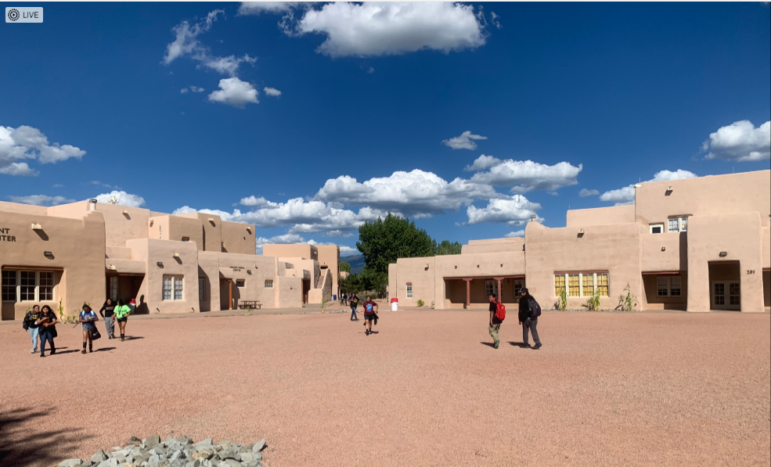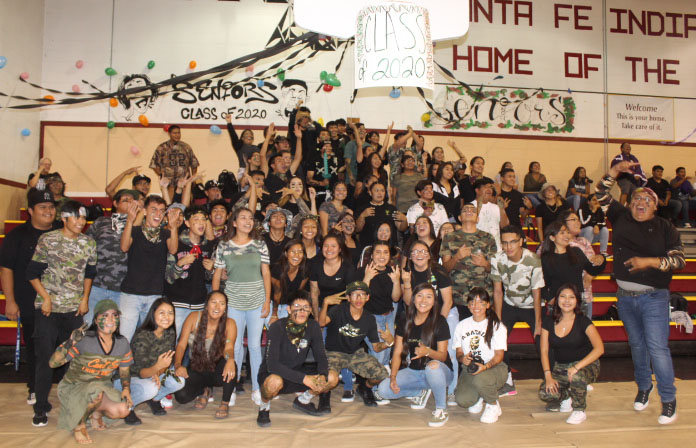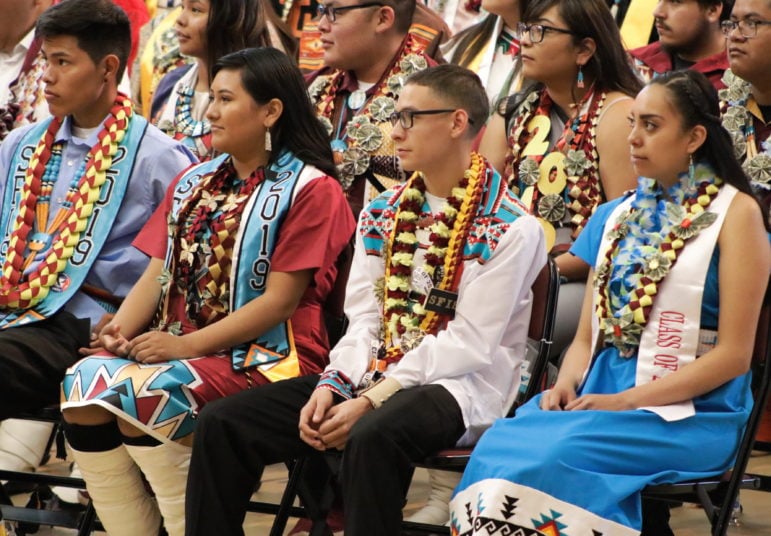
The Santa Fe Indian School campus, photographed this fall, has been closed for the pandemic. Faith Rosetta/SFIS
For their first online assignment, five of Jennifer Guerin’s 15 students in library science submitted homework. She expected it. Library science is an elective at the Santa Fe Indian School and Guerin had encouraged her students to focus on core classes, but the low turnout signaled that a shift to online learning might not work. Even with Chromebooks or laptops sent home with students, teachers had noted about a third of their students weren’t participating in online sessions.
Established in 1890 as a boarding school to assimilate Native American children and reinvented beginning in 1933 as a place centered around Native languages and traditions, the Santa Fe Indian School is now owned and operated by New Mexico’s 19 Pueblos. About 70 percent of the school’s 685 students live on campus.
Ensuring those students can complete their school year during a pandemic, however, is running into America’s digital divide. Tribal communities have lower rates of internet access compared to some other populations, creating a challenge for teachers from the start.
Many of the Indian School’s students sent home to Pueblo and Navajo communities across New Mexico — and a few out of state — have found limited access to the internet, forcing them to borrow hotspots and quickly max out cell phone data plans, or no access at all. Even some teachers returned to communities where they needed to leave the house to find cell reception or WiFi. Their experiences track with a 2016 Federal Communications Commission broadband access report noting that 41% of people living on tribal lands lack access to broadband, with the deficit jumping to 68% for those living in rural areas. New Mexico itself doesn’t perform all that well, either, with Census reporting from 2019 showing only 72% percent of New Mexicans have broadband internet at home, ranking the state 47th in the nation when it comes to internet access.
“It just became very clear that we could not do anything in which we were counting on technology,” said Faith Rosetta, Santa Fe Indian School principal. “You just realize how a school and a school building develop and create a place of equity and when that building is gone, how it all falls apart.”

The Santa Fe Indian School Class of 2020, at a Homecoming pep rally. Faith Rosetta/SFIS
Faced with the reality that digital learning might widen achievement gaps, faculty gathered on video-conferences and drafted a project-based learning component. They designed a five-week series of essay questions and research projects for the seventh to 11th graders designed to keep them thinking critically and engaging with their families and communities, but without needing to access the internet or even leave their homes, with Pueblos on lock-down in mind. Printed copies of the project packets were mailed to all students, and teachers are accepting homework returned via email, mail, even texted photos of handwritten assignments.
The questions and reading material invoke core areas like math, science, and history while being grounded in the historic time they’re living through so students felt some purpose in completing them, said Guerin, who helped draft the 11th-grade curriculum.
Students are prompted to interview older family members about another difficult time in history for the community and how it overcame that challenge. They’re asked to read an article on teen brain development and write about why it might be important to continue doing schoolwork. One question asks students to evaluate methods for preventing the virus from spreading and rank the most important, look for evidence to justify those answers, and then survey other people (by phone) and graph their responses.
“We don’t know how many of these each student is going to be able to complete, but we want to invite them to think with all parts of their brain and heart,” Guerin said.

Santa Fe Indian School 2019 graduation. This year’s ceremony was postponed due to the pandemic. Faith Rosetta/SFIS
Students were also given a suggested weekly schedule and provided ideas for other learning opportunities — baking, cooking, even helping with childcare. Seventh graders were tasked with creating time capsules, and eighth graders with growing something, even if simply a seed in a cup. They’re also reminded to connect with those around them, to exercise, and to contribute to their communities and homes. One of the hopes is that students who live among Native language speakers will use this time to practice.
“We wanted to develop something that was going to be a reflection of their home life and think about those around them and their family members as the main resource for them,” Rosetta said. “The thing that I’m really proud of about our teachers and our continuous learning plan is that it really speaks to who the students are, what the communities are experiencing, and to our core values of perseverance and giving back.”
Faculty also tried to build in sensitivity and flexibility, while reminding students to stay in touch with their homeroom teachers. With more than 50% of New Mexico’s COVID-19 cases affecting Native American people, teachers expect to grant extra time to students living in proximity to illness or death. School counselors have set up telehealth for mental health services to continue. The school nurse is fielding questions by phone.
“That’s the thing we tell the teachers is we just have to really communicate, be flexible, be understanding, and just do our best,” Rosetta said. “It’s not about teaching our students math or science. It’s about ensuring that our students are safe and healthy and have some sense of support.”
Some components of the school year have been shelved indefinitely. Seniors who would present their final projects in an honor project symposium saw that event canceled this year. Some shared their presentation slides on the school’s website. Graduation ceremonies, which students attend in traditional dress and mark with dances, were also postponed. Faculty and parents are discussing alternative approaches like virtual ceremonies or car graduations.
Those enrolled in dual credit courses through the Institute of American Indian Arts, Santa Fe Community College, or the University of New Mexico are struggling to find ways to finish that coursework online or access materials left behind when they went home for spring break and that abruptly turned to an end to the school year. Residential directors are working on sending students’ belongings home to them. For those who can intermittently access the internet, Guerin is sending reminders about resources for downloading ebooks and audiobooks, and databases to read newspapers.
Faculty, parents, students, and tribal leaders will discuss how to approach school this fall. If necessary, Guerin said, the project-based model used this spring could expand to a full semester.
“When we do restart, whatever that looks like, I don’t think we would be doing justice to our profession if we didn’t let this completely new and unprecedented situation push us forward in thinking about how we educate and how we can do it best and equitably for all students,” Guerin said. “But whether or not we’ll be back on campus is probably a pretty serious question that our school will have to contend with.”